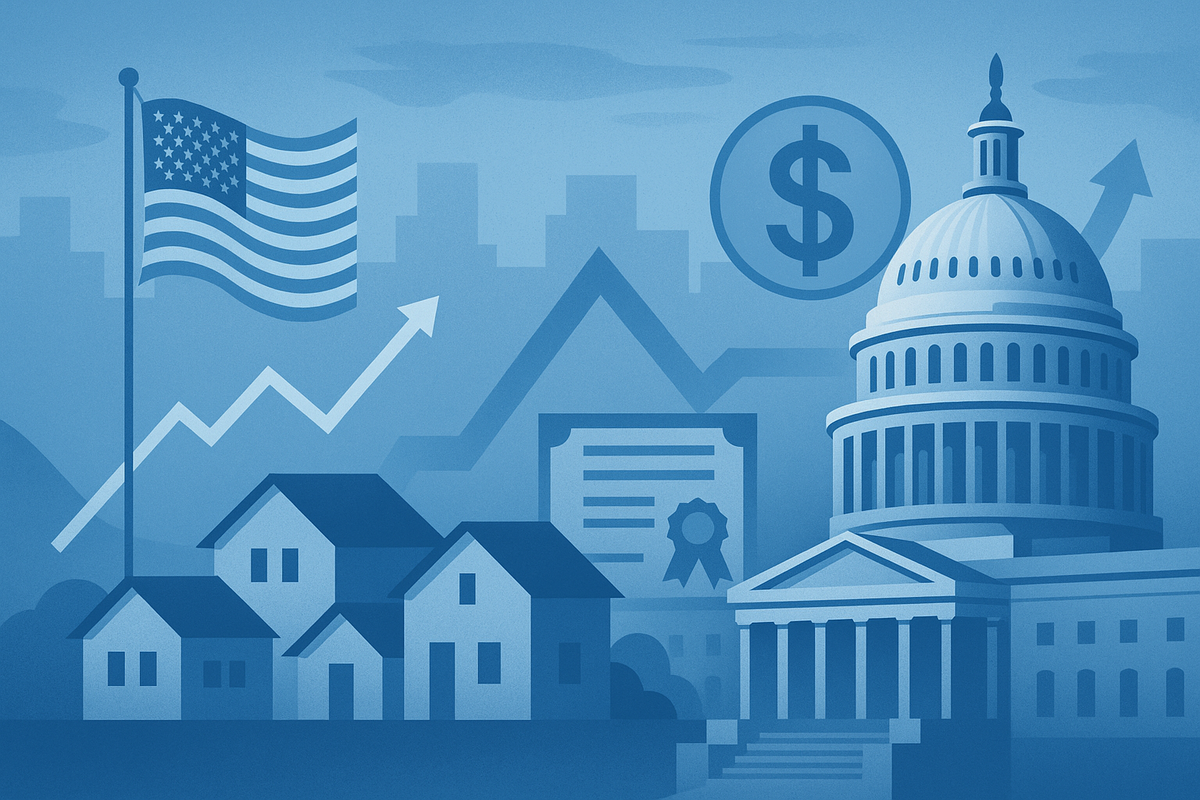A Smarter Way to Recapitalize Fannie and Freddie

Big banks are once again circling Washington, pitching their proposals to lead what could become the largest stock offering in American history: the public relisting of Fannie Mae and Freddie Mac. For Wall Street, it’s the deal of the decade. For taxpayers, it could also be the biggest missed opportunity in years.
There’s a far better way to raise capital, one that strengthens the housing system and returns value to the American public, without giving up government control.
Instead of a traditional IPO that would raise just $30 billion, the Treasury could raise $225 billion today by issuing a 10 percent preferred stock offering. Each preferred share would also include a tradable warrant, giving investors the right to purchase up to 40 percent of the companies’ equity once the combined market capitalization of Fannie and Freddie reaches $1 trillion.
This structure delivers the best of both worlds: a large, immediate capital raise for the government, a competitive return for investors, and a disciplined, market-based path toward ending conservatorship. It’s the rare public-finance design that aligns the interests of taxpayers, investors, and policymakers all without raising mortgage costs for American families.
The Problem with the Status Quo
Fannie Mae and Freddie Mac have been under government control since 2008. For more than a decade, every dollar of profit they earn, roughly $28 billion a year, has gone straight to the U.S. Treasury under what’s called the Net Worth Sweep. The policy was meant to stabilize the system after the financial crisis. Instead, it has frozen both companies in place.
Because the GSEs cannot retain earnings, they can’t build the capital buffers regulators require. That makes them perpetual wards of the state, dependent on federal backing and unable to operate as true market institutions. The current administration has floated the idea of a joint IPO, but that plan would raise only about $30 billion and surrender part of the government’s ownership. It would also introduce volatility into the mortgage market at a time when stability is paramount.
The truth is that the IPO discussion misses the real issue. The goal isn’t just to “take the companies public.” It’s to restore capital, end the profit sweep, and rebuild confidence in the system that finances nearly half of U.S. home mortgages. That requires a financing structure large enough to matter, secure enough to attract institutional investors, and flexible enough to let Treasury maintain control.
The Preferred + Warrant Solution
The preferred offering does exactly that. It allows Treasury to raise the capital it needs now while keeping every lever of control in its own hands.
- Treasury would issue $225 billion in preferred stock paying a 10 percent annual dividend. Investors would earn reliable income, $10 on every $100 invested each year, secured by the government’s position in the GSEs.
- Each preferred share would come with a tradable warrant allowing investors to buy up to 40 percent of Fannie and Freddie’s equity if the combined companies reach a $1 trillion market value. The warrant would give investors meaningful long-term upside while keeping taxpayers first in line.
- The government keeps 100 percent ownership and control of the GSEs, while immediately receiving $225 billion in cash—seven times more than the planned IPO would raise.
That’s the product in one sentence: a hybrid of fixed-income certainty and equity-style upside that works for both sides of the balance sheet.
Why It’s Better for the Government
For Treasury, this plan accomplishes what every administration has failed to achieve since 2008: a clean, orderly transition from conservatorship without political or market chaos.
First, it provides real money now, $225 billion that can be used to strengthen the balance sheet, that is 7x greater than banks talk about reduce deficits, or fund new priorities. By contrast, the IPO plan would generate only a fraction of that amount and force the government to sell off ownership at an uncertain valuation.
Second, allows the government to collect ten years of future cash flows up front, all while simultaneously growing the enterprises. So, while the government will pay out the 10% dividend of $22.5 billion annually, they will also be able to keep any excess profits above that as Fannie and Freddie will thrive in this new environment and grow their earnings at least modestly.
Third, Treasury retains 100 percent control. It decides if and when to call or redeem the preferred shares, and it keeps full policy authority over the GSEs. There’s no dilution of voting power, no risk of losing control to speculative investors, and no immediate privatization pressure.
Finally, this structure provides a clear, staged exit from conservatorship. Once capital is rebuilt and the market stabilizes, Treasury can choose to redeem the preferreds or let the warrants convert gradually, creating an organic, market-driven transition to private ownership.
Why It’s Better for Investors
Investors get something rare: a government-linked security with both yield and growth potential.
At a time when Treasury bonds yield less than half that rate, a 10 percent annual return is highly attractive to pension funds, insurers, and sovereign investors seeking long-duration income. Because the preferreds would trade publicly, they would offer liquidity and transparency similar to corporate preferreds, but with stronger backing.
The attached warrant provides a second dimension. If the combined value of Fannie and Freddie rises toward $1 trillion, a reasonable scenario over time, investors can exercise their right to buy a minority equity stake at that level. It’s essentially a call option tied to the long-term success of the U.S. housing market. That alignment of incentives is exactly what’s been missing from prior reform efforts.
Furthermore, a critical refinement is the anti-dilution provision: if Treasury later sells common equity below the $1 trillion valuation, the warrant exercise price automatically adjusts downward. This eliminates government moral-hazard risk and assures private investors that their capital cannot be diluted by political decisions.
This clause aligns public and private interests, a rare feature in government finance, and would likely command a market premium.
Why It’s Better for the Market and the Public
For the broader financial system, the preferred structure introduces order where there has been uncertainty. The mortgage market depends on confidence in the GSEs’ ability to fund loans at stable rates. A rushed or poorly conceived IPO could unsettle that equilibrium, pushing borrowing costs higher. A preferred issuance, by contrast, leaves the operating model intact while injecting real capital and market discipline.
It’s also a win for taxpayers. The government collects ten years of cash flow up front in the form of $225 billion, and pays out dividends, all while maintaining full control and growing the enterprise.
Politically, the plan bridges the divide between competing priorities. It satisfies those who want to see private capital re-enter the system and those who want the government to safeguard the housing market. It’s not ideological; it’s practical finance.
Comparing the Two Paths
Under the proposed IPO scenario, Treasury would sell shares in Fannie and Freddie to the public, raising an estimated $30 billion while reducing its stake. The IPO would be headline-grabbing but relatively small given the scale of the GSEs’ $7 trillion balance sheet. It would also subject mortgage finance to the mood swings of the equity market and shift control before the system is ready.
Under the preferred plan, Treasury raises seven times more money immediately, keeps full ownership, and creates a defined path to eventual privatization based on performance rather than politics. It’s a more disciplined, investor-friendly way to achieve the same long-term objective.
A Framework That Works for Everyone
This structure isn’t theoretical. It’s built on proven financing principles that governments and corporations alike have used for decades. Preferred equity combines the safety of debt with the permanence of equity. Adding a warrant creates the upside that long-term investors require. Together, they form a balanced capital instrument that generates income today and participation tomorrow.
In many ways, this is the public-finance equivalent of a well-structured partnership: the government provides the platform and oversight, investors provide the capital, and both share in the success. It’s not a bailout, and it’s not a hand-off. It’s a negotiated alignment of incentives.
Restoring Balance
For years, Fannie and Freddie have operated under an artificial constraint, much like an athlete forced to run in place. Every dollar they earn is swept away before it can strengthen the system. The preferred-offering approach restores balance. It rebuilds capital, rewards participation, and protects taxpayers all within a transparent, rules-based framework.
Reform doesn’t have to mean disruption. It can mean modernization. A preferred issuance of this size would demonstrate that the government and markets can work together in ways that serve both stability and growth.
The Bottom Line
Washington has an opportunity to do something rare: craft a financial reform that works in practice, not just in theory. A 10 percent preferred offering with 40 percent warrants would deliver $225 billion to the Treasury today, provide investors with fair returns, and finally create a clear path for Fannie Mae and Freddie Mac to stand on their own.
The math is simple. The logic is sound. And the timing is right.
A smarter recapitalization is within reach. All it takes is the will to choose the plan that raises more money, preserves control, and sets the stage for a stronger, more sustainable housing-finance system for decades to come.





